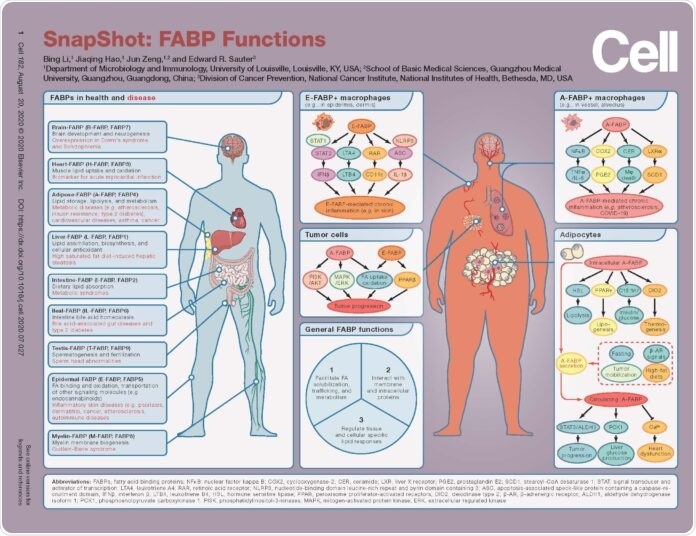Fatty acid-binding proteins, or FABPs for short, function as a kind of chaperone, synchronizing the transport of various molecules, including fatty acids, between cells.

SnapShot created by Bing Li, PhD, to illustrate the functions of fatty acid binding proteins (FABPs). Image Credit: Bing Li/University of Louisville.
Bing Li, an associate professor in the Department of Microbiology and Immunology at the University of Louisville and also a prominent researcher in interpreting the function of FABPs has produced a “SnapShot” of FABP functions.
The study has been published in Cell—a leading scientific journal focused on cell biology.
A minimum of nine types of FABPs, classified according to the organs and tissues in which they were initially found, are known to play various roles in the metabolism of lipids. Although these FABPs are responsible for significant functions in sustaining health, obesity can lead to higher concentrations of these proteins, triggering disease.
When people are obese, FABPs in different cells and tissues are upregulated, resulting in changes in lipid metabolism and responses.”
Bing Li, Associate Professor, Department of Microbiology and Immunology, University of Louisville
Li’s study targets the function of FABPs in cancer development, obesity, and chronic inflammation. Recently, he published a proposed mechanism to demonstrate how high concentrations of one of these proteins, FABP4, emerging from higher amounts of fat tissues support the growth of breast tumors.
Studies from my laboratory demonstrate that FABP family members, especially FABP4 and FABP5, are critical in mediating obesity-associated diseases by regulating immune cell functions. Thus, our studies on FABPs not only uncover the underlying mechanisms by which obesity undermines human health, but also provide new targets for novel immunotherapeutic strategies for clinics.”
Bing Li, Associate Professor, Department of Microbiology and Immunology, University of Louisville
Li was invited by editors of the Cell journal to produce the SnapShot to demonstrate the roles of all familiar FABPs implicated in disease and health, with a focus on their role in cancer, chronic inflammatory disease, and obesity. SnapShots are graphic sketches developed to act as quick reference guides for scientists working on a particular subject.
The SnapShot format offers a great deal of opportunity for creativity and can be printed and pinned above lab benches to jog researchers’ memories. While our studies open a window to see the important functions of FABP family members in some disease contexts, a lot of questions remain unexplored in this field. I hope this piece will encourage more young scientists to contribute their talents to combat obesity and obesity-associated diseases.”
Bing Li, Associate Professor, Department of Microbiology and Immunology, University of Louisville
Source:
Journal reference:
Li., B., et al. (2020) SnapShot: FABP Functions. Cell. doi.org/10.1016/j.cell.2020.07.027.